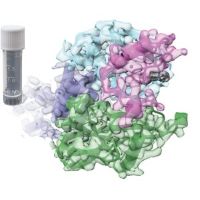Specification
| Alternative Names | GPC3 |
| Uniprot ID | P51654 |
| Tag | Tag-Free |
| Size | 1 vial contains approximately 5x106 cells in 1 ml |
| Screening Marker | Puromycin |
| Culture Media | DMEM + 10% FBS + 10μg/mL Puromycin |
| Buffer | 35% FBS + 55% DMEM + 10% DMSO |
| Tested Application | Binding assay by FACS and cell based ELISA. |
| Storage | Frozen in liquid nitrogen or stored at -80°C |
Background
| Function | Cell surface proteoglycan that bears heparan sulfate. Negatively regulates the hedgehog signaling pathway when attached via the GPI-anchor to the cell surface by competing with the hedgehog receptor PTC1 for binding to hedgehog proteins. Binding to the hedgehog protein SHH triggers internalization of the complex by endocytosis and its subsequent lysosomal degradation. Positively regulates the canonical Wnt signaling pathway by binding to the Wnt receptor Frizzled and stimulating the binding of the Frizzled receptor to Wnt ligands. Positively regulates the non-canonical Wnt signaling pathway. Binds to CD81 which decreases the availability of free CD81 for binding to the transcriptional repressor HHEX, resulting in nuclear translocation of HHEX and transcriptional repression. Inhibits the dipeptidyl peptidase activity of DPP4. Plays a role in limb patterning and skeletal development by controlling the cellular response to BMP4. Modulates the effects of growth factors BMP2, BMP7 and FGF7 on renal branching morphogenesis. Required for coronary vascular development. Plays a role in regulating cell movements during gastrulation. |
| Subcellular Location | Cell membrane; Lipid-anchor, GPI-anchor; Extracellular side. |
| Tissue Specificity | Highly expressed in lung, liver and kidney. |
| Protein Family | Glypican family |
| References | The areas under the receiver operating curve (AUROC) value, sensitivity and specificity of glypican 3 (GPC3) for hepatoblastoma (HB) pretreatment group versus all controls were all significantly lower than those of alpha-fetoprotein (AFP). PMID: 28378832 GPC3 is operating through an intricate molecular signaling network. From the balance of these interactions, the inhibition of breast metastatic spread induced by GPC3 emerges. PMID: 30267212 Its surface is modified with anti-GPC3 antibody. PMID: 29916268 data suggest that transcriptionally targeted delivery of transgene in HCC cells can be achieved using the GPC3 promoter and this targeting strategy produces limited toxicity to normal liver cells PMID: 29563582 High GPC3 expression is associated with Hepatocellular Carcinoma. PMID: 28429175 |
QC Data
| Note | Please contact us for QC Data |
| Product Image (Reference Only) |  |

